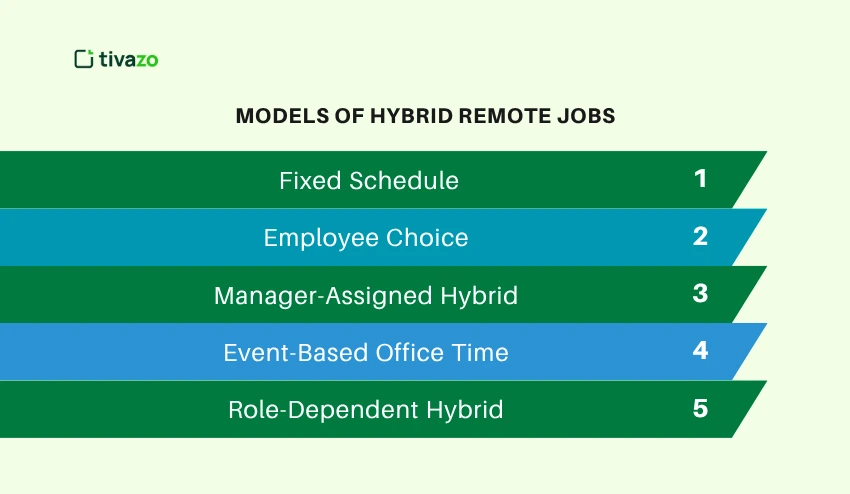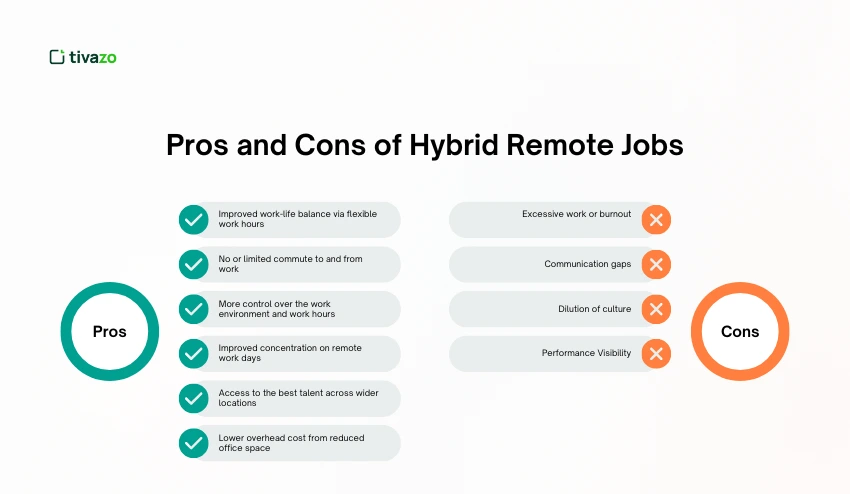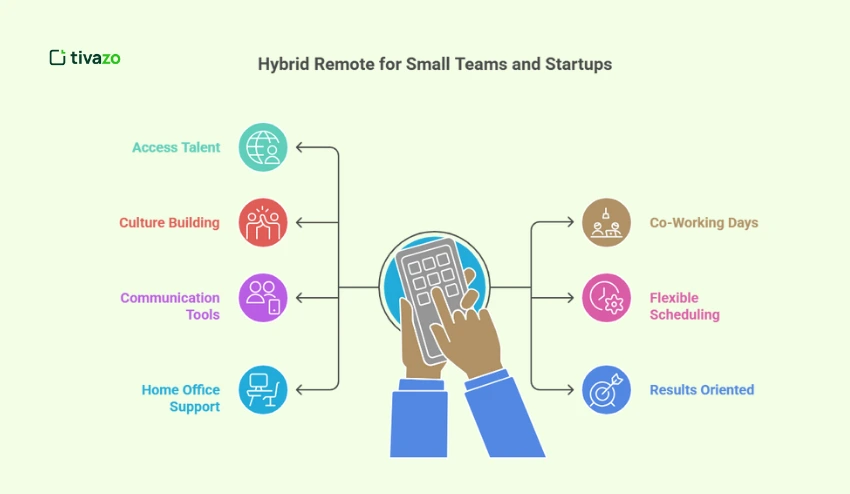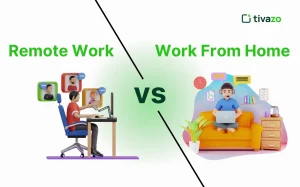As working from anywhere has become the new normal, the term hybrid remote jobs has started to evolve into one of those used by employers on job boards, LinkedIn, and Zoom calls. But what is hybrid remote work? And why is it the future of work for so many companies and employees?
A hybrid remote job is not just a buzzword — it represents a new reality in work culture. It allows for in-person collaboration with the flexibility of working from home. It’s not just about where you work, it’s also about how you work, and looking for a golden balance between structure and freedom.
This is the internet’s most comprehensive guide to understanding hybrid remote work. By the end of this guide, you will not only find out what a hybrid remote job is, but you will also understand the models, benefits, challenges, and, just maybe, determine if it’s the right career decision for you.
Key Highlights:
- Models of Hybrid Remote Jobs
- Who Thrives in Hybrid Remote Jobs
- Pros and Cons of Hybrid Remote Jobs
- Career Growth in Hybrid Remote Roles
- Hybrid Remote for Small Teams and Startups
What Is a Hybrid Remote Job?
A hybrid remote job typically enables you to divide your schedule between remote work, frequently from the comfort of your home, and working from a prescribed physical location (often an office). In other words, you are able to enjoy the benefits of both on-site and remote positions; remote employees typically have much greater agency in terms of where and how they work.
Each organization and position will define hybrid remote work differently; some are adamant about specific in-office days, while others focus on getting together in person whenever it is most convenient. Some hybrid remote positions are primarily remote-first roles, but require face-to-face meetings once a month or so. Other organizations may have a primary office location, but hybrid remote employees may consider working regularly from remote locations or have greater flexibility.
So, to sum it up, if you have been wondering about the hybrid remote job definition, it is simply a flexible work model that is not fully remote and not fully in-person. Hybrid remote work provides the hybrid model to attract the best of both workspaces.
Hybrid Remote Job vs. Hybrid Work: What’s the Difference?
Let’s clarify a major confusion:
- Hybrid Work = a company policy or model
- Hybrid Remote Job = a specific job/role that follows a hybrid setup
A company may offer hybrid work, but not all employees may have the same arrangement. A hybrid remote job clearly outlines how much of your role is remote.
| Term | Applies To | Example |
|---|---|---|
| Hybrid Work | Company-wide structure | Google’s 3-day in-office policy |
| Hybrid Remote Job | Specific role or listing | “Marketing Coordinator (Hybrid Remote)” |
If you’re scanning job boards and see “hybrid remote position,” it usually signals that you’ll be expected to come into the office on a part-time basis while still enjoying remote days for focused work.
Models of Hybrid Remote Jobs: How It Works
When it comes to the hybrid remote work definition, it is important to know where exactly the different models fit so that you can choose a model that fits you best. Hybrid positions do not all operate under a single model, but instead, they operate under different models depending on company policy, the requirements of the role, and the culture of the team.
Here are the most common models of hybrid remote jobs:

a. Fixed Schedule (e.g., 3 days in-office)
The fixed schedule model requires a specific number of in-office days, which can be dictated by the company, for example, every Monday through Wednesday in the office, and Thursday and Friday are remote. The fixed schedule model is the model of choice found in traditional corporate environments. It recognizes the need for advanced planning, offers consistency, and assists leadership in scheduling meetings and coordinating group effort.
However, it can create challenges for employees who would appreciate additional flexibility due to childcare, travel, or personal productivity schedules. On the other hand, for those who prefer order, this type of hybrid remote job helps create a structure.
b. Employee Choice
Under the employee-choice model, workers determine what days they will come to the office versus work remotely. Companies typically set a minimum requirement of “two days per week onsite,” but organizations will allow individuals to choose the days they work in, and the days they work from home. This model is the model of choice for startups and more modern technology companies where flexibility and autonomy are part of the culture.
While the employee-choice model cultivates trust and may enhance employee morale, it can also limit opportunities for unplanned collaboration or co-creation. However, for many professionals exploring hybrid work, this is ideal for work-life balance.
c. Manager-Assigned Hybrid
This structure allows individual managers to assign specific in-office days based on their team’s needs. It provides the flexibility of a hybrid model while allowing teams to synchronize their work. Also, it will benefit more strategic projects that may require coordination with others.
While this version of a remote hybrid position may limit personal autonomy, it creates cohesion and synchronization for the team, especially useful for cross-functional teams that rely heavily on engaged real-time collaboration.
d. Event-Based Office Time
This model provides the least defined level of remote work as a hybrid remote job. Employees are not required to be in the office every week. Instead, employees come in person for key events (team-building, strategy workshops, and important client presentations).
This option is gaining acceptance and is becoming increasingly popular among globally distributed teams that value a degree of flexibility and the ability to establish in-person connections at times. It also fits a results-oriented culture by focusing employees less on hours and more on the results of their contributions.
e. Role-Dependent Hybrid
Depending on the company, hybrid expectations and structures might vary depending on a person’s job function. A software developer, for instance, may be required to come to the office every month for a sprint planning meeting, while a customer success manager might work more often in an office to support client onboarding.
This model allows for different levels of physical presence, of course, because not every job needs the same level of physical presence. Hybrid can be tailored to the needs of the business, and is arguably the most sensible model for a larger organization that has many different businesses to manage. Knowing what a hybrid remote job is from this model allows candidates and employers to map expectations to reality.
While each of these models provides benefits and drawbacks to the user, whether you prefer structure, independence, or flexibility in your job, making a distinction about which model fits your lifestyle can be the key to being successful in a hybrid remote role.
That being said, while you’re asking yourself what a hybrid remote job is that suits your needs, consider how much structure you need, your tolerance for commuting, and your preference for collaboration versus individual quiet time.
Who Thrives in Hybrid Remote Jobs?
A hybrid remote job is great for people who want the independence while still engaging socially with work. People who are self-starters with well-established home offices usually thrive, since they’re able to stay on task without anyone looking over their shoulder, while still being hosted in person by other professionals who might spark new ideas or renewed energy. On the other hand, those individuals simply do not like commuting but enjoy the occasional face-to-face working environment, and find hybrid remote jobs liberating.
Some of the roles that may lend themselves the most to a remote hybrid position are marketing, product management, content creation, data analysis, and HR. All of those roles need deep focus while regularly rallying up the staff — a perfect fit for the hybrid job, so you get productivity with flexibility.
Pros and Cons of Hybrid Remote Jobs: What You Need to Know
Pros and Cons of Hybrid Remote Jobs are:

Pros:
- Improved work-life balance via flexible work hours
- No or limited commute to and from work
- More control over the work environment and work hours
- Improved concentration on remote work days
- Access to the best talent across wider locations
- Lower overhead cost from reduced office space
Cons and Smart Solutions:
- Excessive work or feeling of burnout: Set clear on and off hours. Increasing calendar transparency will help
- Communication gaps: Address with asynchronous communication and updates with potentially tools like Loom and Slack. Follow-ups could involve a daily standup or touch base every day.
- Dilution of culture: Combat dilution of culture by developing shared virtual rituals. Offer employees frequent in face bonding moments in the office (Example like once a month, a specific lunch just for bonding).
- Performance Visibility: Using tools like OKR will help with visibility. Weekly communication with employees about progress will also help with accountability.
How to Find (and Get) a Hybrid Remote Job
As you begin your hybrid remote job search, you want to get specific in how you are searching. The first step is to facilitate your job search by creating filters on job searching platforms like LinkedIn. Use the word “hybrid” in the job search filters, and you will have plenty of hybrid options that facilitate flexible work. Spend time on the career pages of remote-first organizations to expose yourself to many remote-hybrid positions. Sites like Remote.Co, We Work Remotely, and AngelList are some specialized job boards for hybrid job searching.
During interviews, be sure to ask questions. Here are a few examples: “How frequently does the team meet in person?” or “Is the remote scheduling flexible or fixed?”. Overall, these types of questions help you more fully understand what a company expects of hybrid remote work and if the hybrid remote position will meet your needs.
Following these strategies when searching for a hybrid remote position will provide you with the best opportunity of finding your ideal hybrid remote job that complements your lifestyle and career ambitions.
The Future of Hybrid Remote Work
The future of hybrid remote work is moving forward quickly, and there are some compelling trends to pay attention to. Four-day hybrid workweek plans are becoming more popular to provide the most flexibility to employees and help bridge a work-life balance.
AI tools for enhanced collaboration are continually áre becoming more available every day. Overall, with so many tools available to them, remote collaboration has never been more accessible.
Virtual office platforms like Gather and Teamflow mimic physical interactions to create the vibe of working together, and companies are increasingly moving to async-first hybrid policies that provide greater flexibility for people across time zones. It feels like hybrid remote work has gone beyond being a perk or bonus and is becoming the new normal.
Understanding hybrid remote work definitions, along with the hybrid remote work trend, will be a future of work skill.
Career Growth in Hybrid Remote Roles
Growth in hybrid remote roles is dependent on consistent communication and visibility. You can develop your network and presence with your manager and mentors by scheduling regular one-on-one meetings. It’s important to keep your wins visible through communications, such as posting on Slack or sending emails to your colleagues, so they know you are contributing.
Asking for feedback will help improve your performance continuously, and if you keep your wins documented in an app like Notion or your team’s updates, it can serve as a history of your accomplishments. It helps to remember in a hybrid situation that visibility is key to career advancement and staying top of mind.
Salary Expectations in Hybrid Roles
Salary expectations for hybrid remote jobs depend on the various locations and the policies of the hiring company. Typically, hybrid remote jobs in major metropolitan areas will offer salaries that are 5-15% lower than their fully on-site counterparts and higher than a fully remote role.
Companies do sometimes pass some of the savings to their workers either through stipends or bonuses, or by having fewer permanent or mostly permanent employees coming into the office and less of a burden on managing office space.
You should research competitive pay for your professional field and understand the salary for hybrid remote work through resources such as Glassdoor, Levels. fyi, or Blind. Please ensure you can demonstrate your value.
Hybrid Remote for Small Teams and Startups

- Access Talent: Hire beyond your local geographical limits without the headache of a costly headquarters.
- Co-Working Days: You can encourage people to regularly co-work as teams weekly in person (or virtually).
- Culture Building: You can easily replicate rituals virtually and plan meetups on the calendar.
- Flexible Scheduling: You can meet the needs of your varying work styles and requirements.
- Communication Tools: Every member must always ensure everyone is on the same page and understands their commitments.
- Results Oriented: Focus on the results of the work completed, not the hours worked.
- Home Office Support: Consider supporting each employee to set up their remote workspace with a/home office stipend.
Final Thoughts: Is a Hybrid Remote Job Right for You?
If a mixture of freedom and structure appeals to you, consider a hybrid remote position for the best of both worlds. Hybrid work allows you to collaborate in person with your team when it matters, but then have control over your surroundings on remote workdays. If this flexibility suits your preferences, it can also enhance productivity, lessen burnout, and improve work-life integration.
By understanding what a hybrid remote job is, you can gain confidence in navigating the future working world, knowing you will make the right choices for your style of work and path of career path. Hybrid positions are adaptable to various needs, whether you need connection, autonomy, or both.
FAQs
How many in-office days are typical?
Usually 2–3 days per week, but it varies by company.
Is hybrid better than fully remote?
It depends—hybrid offers balance, fully remote offers more freedom.
Do hybrid jobs pay less?
Often slightly less than on-site, but more than remote roles.
Is hybrid remote good for career growth?
Yes, if you communicate well and stay visible.




